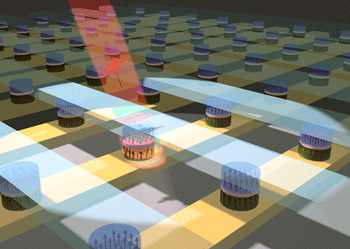Flipping a Magnetic Memory Cell with a Light Pulse

(03/01/2017) - Scientists at the University of Minnesota have created a magnetic tunnel junction (MTJ) that can be switched by a pulse of light lasting one trillionth of a second, setting a speed record. The magnetic tunnel junction is a device critical to information technology with the termination of Moore’s law, a principle that has ruled the microelectronics industry for five decades.
This advancement holds promise for the development of new, optically controlled, ultrafast magnetic devices collectively called spintronics (electronics that combine optical and magnetic nanotechnologies). These devices could lead to innovations in the storage, processing, and communication of information in the coming decade. An example of such innovation would be the development of a system that like the human brain, can both store and analyze a large amount of data simultaneously.
The details of the device and the tests conducted on it are reported in the paper “All-optical switching of magnetic tunnel junctions with single sub-picosecond laser pulses,” published on Feb. 28 in the journal Physical Review Applied.
Typically, the MTJ has a sandwich-like structure comprising two layers of magnetic materials with an insulating layer, called barrier, in the middle. Information is written on the magnetic material by reversing the magnetization of one of the layers. This reversing process often involves spiral motion in the spinning electrons, called spin processing. However, there are is a limitation on how fast the spin processing can be; the brakes are applied at roughly 1.6GHz, a current speed record that is much slower than silicon transistors. To enable faster writing speeds, the limitations on speed have to be overcome.
With the invention of a new MTJ by scientists at the University’s Department of Electrical and Computer Engineering, there is now a way to speed up things. Inspired by the 2007 discovery by Dutch and Japanese scientists that the magnetization of an alloy of gadolinium (Gd), a rare earth element, iron (Fe), and cobalt (Co) could be switched using light pulses, our scientists used the alloy to replace the upper magnetic layer of a conventional MTJ. Another modification they made to the device was to use a transparent electrical material called indium tin oxide for the electrode to allow light to pass through it. These layers are stacked into a pillar with a diameter of 10µm, which is only one tenth the diameter of a typical human hair.
To test, scientists sent laser pulses to the modified device using a low-cost laser based on optical fibers that emits ultrashort pulses of infrared light. The pulses are sent one in every microsecond (a microsecond is one millionth of a second). Every time a pulse hit the MTJ pillar, the scientists observed a jump in the voltage on the device. The change in voltage confirms that the resistance of the MTJ sandwich changes each time the magnetization of the GdFeCo layer is switched. Because each laser pulse lasts less than 1 picosecond (a millionth of a microsecond), the device is capable of receiving data at a rate of 1 terabit per second!
For Prof. Mo Li, one of the lead scientists, the outcome holds exciting prospects. “Our result establishes a new means of communication between fiber optics and magnetic devices. While fiber optics afford ultra-high data rate, magnetic devices can store data in a non-volatile way with high density.”
According to C-SPIN director, Prof. Jian-Ping Wang, also a lead scientist on the project, “The results offer a path towards a new category of optical spintronic devices that have the potential to address bandwidth limit and scaling challenges for future intelligent systems. These systems could use spin devices as neurons and synapses to perform computing and storage functions just like the brain, while using light to communicate the information.”
The ultimate goal for this research team is to shrink the size of the MTJ to less than 100 nanometers and reduce the required optical energy. To this end, the team is continuing its research, and is currently engaged in optimizing the material and structure of the device, and working on integrating it with nanophotonics.
In addition to Prof. Mo Li, and Prof. Jian-Ping Wang, postdoctoral associate Dr. Junyang Chen, and graduate student Li He, who made equal contributions to the work, are the leading authors of the paper. This work is supported by STARnet, a Semiconductor Research Corporation program, sponsored by MARCO and DARPA.


